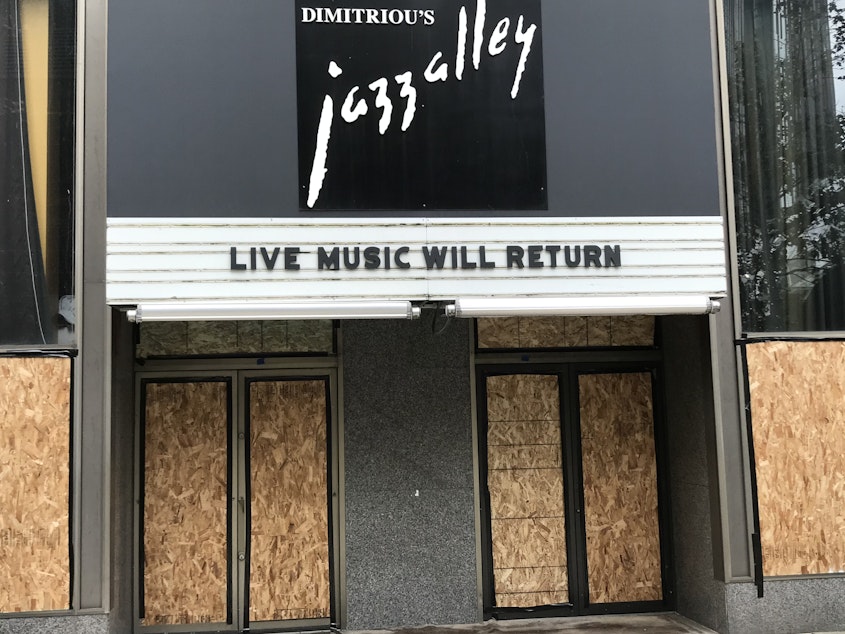Can Seattle arts groups survive the pandemic?

Coronavirus is surging yet again in Washington state. Public health officials are on edge. So are businesses that depend on people gathering together in enclosed spaces.
That includes the arts and culture sector.
According to an October survey conducted by the Seattle advocacy group Arts Fund, almost 5,000 people lost jobs with cultural organizations when the pandemic hit last March. Only 9% have been rehired, and many of those came back to reduced hours and paychecks.
Although many area museums reopened to in-person visitors earlier this fall, they’re restricted to 25% of their normal audience capacity; with virus infections on the rise, they're bracing for another round of social gathering restrictions.
Every performing arts organization that responded to the Arts Fund survey indicated they had pivoted to streamed digital content and planned to retain online content even after the pandemic eases and they can welcome back live audiences.
“The new revenue component is going to be essential,” says Michael Greer, Arts Fund CEO. "It kind of fills the void of individuals' trepidation of moving back into theaters."
Local audience polls have revealed the majority of patrons are reluctant to return to theaters until an effective coronavirus vaccine is widely available.
Sponsored
Greer believes digital content is the future, but says cultural groups must prioritize funding for the necessary equipment and infrastructure crucial to quality streaming.
Arts organizations may be forging ahead with digital programming, but they acknowledge it’s not financially sustainable to rely solely on online content.
Pacific Northwest Ballet, for example, is charging $190 for a full subscription to its 2020-2021 digital season. That compares to $150 for a single top-line seat at McCaw Hall, PNB’s home. Nevertheless, the ballet company is forging ahead with its all-digital season, including the first-ever online presentation of its holiday classic, “The Nutcracker.” Seattle Opera also is experimenting with digital programming, and the Seattle Symphony Orchestra is streaming live and pre-recorded performances.

Meanwhile many area theaters have turned back the clock; they’ll offer radio dramas this season, including a new audio version of ACT Theatre’s venerable holiday offering, “A Christmas Carol.” Most performing arts venues in the area had already decided to remain closed to live audiences through mid-2021, but that doesn’t make them any less worried about the future.
Sponsored
Randy Engstrom, director of Seattle’s Office of Arts and Culture, says the cultural sector was balanced on a knife’s edge before the pandemic hit.
“It was devastating,” Engstrom says. “That devastation was disproportionately felt by BIPOC artists and organizations, because they’ve been underinvested and undercapitalized for so long.”
The racial justice uprising did spur some individual donations to some Black-led cultural groups.
Elisheba Johnson, one of four people directing the Central Area arts and community center WaNaWari, says while she’s prone to be the financial worrywart of the quartet, WaNaWari has already brought in half the money it needs to continue operating through 2021.
But many other small groups don’t have the cash on hand to survive past this winter.
Sponsored
Engstrom’s office has been working on plans to adapt the Great Depression-era Works Progress Administration (WPA) for the Covid-era. The idea is to fairly compensate artists for their work on civic recovery projects; everything from continuing to paint the murals that have blossomed on boarded-up storefronts to digital arts curricula distributed to public school students across the city.
Although local officials like the idea, Engstrom says it would require a cash infusion from the federal government.
Despite the challenges, Engstrom is optimistic that Seattle-area artists and arts groups will weather the current storm, somehow.
“I’m hopeful because of the incredible resilience I’ve seen,” Engstrom says. “We need to meet that resilience with dollars, and faith in artists’ work.”




